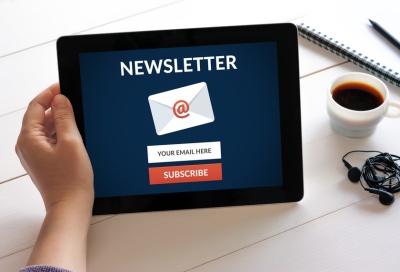Company newsletters are an important means of communication for businesses. They allow business owners to share pertinent news, updates, events, and other vital pieces of information with existing and prospective customers. They are a valuable way to keep the lines of communication open with contacts and customers. In this article, we discuss the importance of a company newsletter and share ideas for creating effective newsletters that will garner results.
A company newsletter is a publication that is distributed on a regular basis – weekly, monthly or quarterly, for example – to a targeted audience of customers. Newsletters can be printed and mailed via the post office, or they can be sent through email. They can be used as a means of advertising, or they can simply be used to share new ideas, events or any other information that customers would be interested in. In addition to being a great tool for connecting with consumers, newsletters are also an excellent way to stay connected with other pertinent stakeholders, including managers, employees, and even those who own stock in a company.
The Benefits of a Company Newsletter
Sending out regular newsletters can prove to be very beneficial for business owners. Some of the key benefits of newsletters include:
- Increased brand awareness. By sending out newsletters, a business can keep their brand in the forefront of customers’ minds. When they wish to purchase a similar product or service in the future, they will be more likely to turn to the company that sent out a newsletter highlighting what they offer.
- Build credibility. A company that sends out regular newsletters builds its credibility. People are more likely to trust a business that keeps them in the loop about important news and information. The more credible a business is, the more successful it will be.
- Opens communication. In today’s highly competitive marketplace, open lines of communication are extremely important. By discussing important information with stakeholders, a business can get a leg up on the competition. Newsletters are an easy and effective way to keep the lines of communication open.
- Builds relationships. Regular newsletters are also an excellent way to foster relationships with stakeholders. Strong relationships lead to strong and successful businesses.
- Increased sales. By sending out newsletters, a business can easily boost their sales. Newsletters can contain highlight new products and services, discuss ideas, and share other valuable information; all things that can lead to more sales.
Company Newsletter Ideas
Now that you know the benefits a company newsletter can provide, it’s time to draft your first one. How can you go about creating a newsletter that will get you the results that you desire? Here are some ideas to keep in mind when creating a newsletter for your company.
- Create an eye-catching name. Think of a clever, attention-grabbing name for your newsletter. While you can use the name of your company, it probably isn’t going to catch as much attention as something that has a bit more pizzazz. Think of a title that relates to your business and is easily distinguishable, yet will encourage people to open up the newsletter and read more.
- Be objective. While a newsletter can be a great tool to promote the products and services your company offers, you don’t want it to seem as if it’s a sales brochure. Use a “soft sell” approach for whatever you are promoting. If it seems to salesy, your audience isn’t going to be interested in reading it. Take an objective approach when writing your newsletter. Mirror the tone of a newspaper article. Incorporate factual information and write in the third person. The newsletter will appear much more professional and it will get a much better reception.
- Express, don’t impress. The point of a newsletter is to communicate. While you might be tempted to use big words to sound more intelligent, the truth is that the average reader might find it difficult to comprehend what you are saying. Use everyday language that people of all reading levels can easily understand and relate to. If you are going to use acronyms, understand that not everyone will know what they mean. To avoid confusion, state what they stand for and add the acronym after (search engine optimization followed by SEO, for example).
- Proofread and edit. Never, under any circumstances, send out a newsletter before you proofread and edit it. Even if you think it’s spot-on while you’re drafting it, there’s a chance that it could contain typos and grammatical errors. Make sure you go over it with a fine-tooth comb before sending it out and make any necessary changes. Remember, your newsletter represents your company; if it’s sloppy and appears like it written hastily, people are probably going to assume that your business isn’t very professional.
